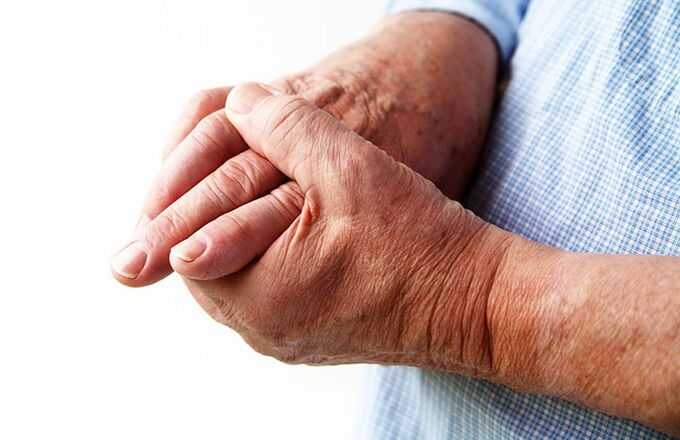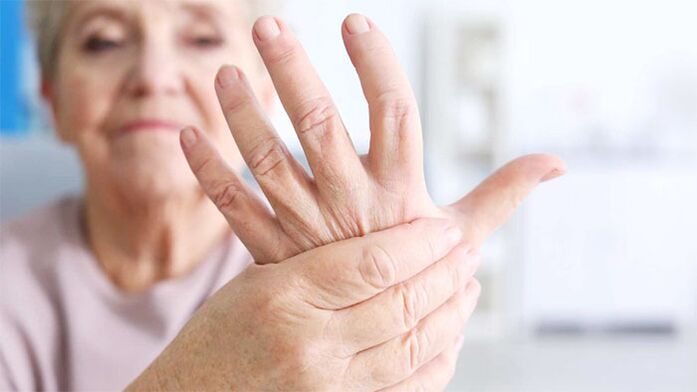What can pain in the joints of the fingers be?The causes are in various pathological conditions that are diagnosed in a timely manner.When it is known that he has caused such a symptom, it is much easier to deal with.Modern methods of treatment and preventive measures will help to quickly and effectively eliminate the pain and the hands of healthy movement.If the pain progresses, it will only worsen and people feel helpless in ordinary situations.In this case, it is important not to be confused and to get the right tactics.

Why is this symptom?
Such a manifestation may indicate many diseases.The characteristics of symptoms and related clinical signs help to determine which pathology is impressed with the fingers.
Most often, there are such options:
Rheumatoid arthritis.This disease is autoimmune.The pathogenetic mechanism can be explained as follows: In some cells, the body and receptor protection system defines its own structures as pathogens.As a result, autoantitis develops, which forms immunocomplexes.
This, in turn, is amazed at the health of its own tissues and causes inflammatory processes.Thus, arthritis develops - joint tissues and structures are destroyed, changes in all structures, function, pain in the joints of the fingers appear.The disease may begin at a young age, but especially in older patients, as the destruction of the tissues reach a significant degree.
Both limbs suffer - the peculiarity of the disease is in the symmetrical localization of the symptoms.The long course of pathology causes constant deformation and the fingers will become a curve, causing their motor action.Patients lose the ability to perform simple actions and gradually come to the disability.
Gout.The essence of the disease is a disruption of the metabolism of purine and uric acid products.Also, in ancient times this pathology was called "kings' disease" because it develops in the wake of increased consumption of meat products.Smoked meat, sausage and alcohol.
When metabolic processes are disrupted, UTS - Acid salts begin to circulate in the blood.They affect the structure of the joint, cause inflammation and can cause a sharp attack of pain in the joints of the fingers.Gout has its own peculiarity - most often, it affects the first (large) finger joint of the foot and is so intense that one cannot sleep, move and feel severe.
After that, when the disease spreads, the hands are affected - the joints of the fingers are deformed, the pain in them begins to bother.Near the joints that connect the phalanxes, specific seals can be fixed.Pain naturally burns intensively, removed only with the help of strong drugs.
Osteoarthritis.This disease develops gradually because the articular surfaces and cartilage tissue are exhausted.Bone growth begins, part of the joint is destroyed, and osteoarthritis can be considered progressive.At the same time, the pain is observed, which occurs in the light of physical activity.The disease is more characteristic of an older age group, but may be reported in young patients if there are injuries, or there is a hereditary tendency.In addition to fingers, carpal joints, elbows, shoulders can be bored.
After a short rest, the pain goes away, but it returns at the beginning of the movement.Deformation causes a constant symptom - sometimes even altered areas are impossible due to severe pain.In order to instinctively reduce the pain, a person constantly limits movements in the affected joints.
Arthritis.It is a group of inflammatory diseases that can occur in the presence of a specific pathogen in the body.Infectious pathology is always accompanied by inflammation and tropna (sensitive) some microorganisms in the joint tissues.The disease can occur acute or chronic, depending on the symptoms.
In the first case, the pain in the joints of the fingers develop sharply, accompanied by swelling, redness of the skin, and limitation of mobility.The chronic form causes weakly pronounced symptoms that can become more severe or change with the remission phase.
Pain is also observed with traumatic fingers.These can be fractures, dislocation, strong bruises, or a heavy object.Because the palm skin is quite dense, swelling does not have enough space for spread and the patient feels severe pressure, severe swelling and swelling.
The more extensive the injury, the more intense the pain.The effects of injury can lead to chronic pathology, and in the early period it is accompanied by limitation of mobility and hand function.
As you can see, there are many causes of pain in the fingers.It is important to find out in a timely manner what caused the cause of poor health and effective treatment in a particular patient.
What symptoms can be accompanied by?
In addition to pain, concomitant symptoms can be observed, which can be easier to identify the abnormal condition that can cause pain.If you feel pain in the joints of your fingers, you should pay attention to the following manifestations:
- Station in the joints
This is a restriction on mobility that can be seen in the morning hours.In order for mobility to return with your fingers, the patient must strike them, perform a small charge, and only then perform the usual actions.
- Edema
The appearance of soft tissue edema is accompanied by their local seal, the increase in volume, and can be combined with the rest of the inflammatory process.
- The redness of the skin above the joint
It is observed during its deformation when the skin stretches and becomes thinner.
Also, redness is always accompanied by an inflammatory process.
- Functional disorders
Most often, pain does not reduce the usual volume of movements.It may be difficult to move or in its complete absence.The condition is affected by a long course of the disease.
- Deformation
Over time, the fingers become curved, in a bent position, which impedes the usual case and deprives the hands of the aesthetic component.
- The appearance of specific deposits
It can be gouty tofus, nodes for arthritis.Small seals appear under the skin that are painless but may cause discomfort.
- General symptoms
Against the backdrop of pathology, general weakness, emotional background change, poor sleep, decreased appetite, temperature rise, decreased performance, lethargy.
Related symptoms can say a lot about the cause of pain in the joints of the fingers, so you should be careful to listen to the body during the disease.

Diagnosis of pain in the joints of the fingers
You can start with high quality treatment after determining the cause of the condition.Modern diagnostic methods are used for this.First of all, this is an analysis of anamnetic data obtained during a thorough survey.After that, the affected areas are checked.This data may become the basis for a preliminary diagnosis, as information on the onset of the disease and its gradual development, complaints of related symptoms allow you to suspect the cause of the condition.
Laboratory diagnostic methods are used.General analysis can show the characteristic changes in the inflammatory process.Increased ESR rate, slight leukocytosis will say on it.Specific immune reactions occur in chronic rheumatic pathology.Changes in uric acid metabolism allow you to doubt.Urine analysis relating to general clinical trials and all patients can also be said to be metabolic disorders.
Instrumental diagnosis is most often made using x -ray.In the picture you can show bone growth, changes in joint surfaces, gap between the two parts of the joint, narrowing, finger fracture or dislocation.Soft tissue is also required for which tomography or ultrasound diagnosis is used.
Research methods are used to determine the diagnosis as well as for dynamic monitoring of the patient's condition.Depending on the changes of the indicators, you can change the treatment tactics and make a prognosis for recovery.
Modern methods of treatment
Various conservative and operational methods are used to treat pain in the joints of the fingers.
Not among the surgical methods, the following stands out:
- Physiotherapy;
- Drug treatment;
- Therapeutic charging;
- Folk methods.
Surgical treatment is directed in very rare cases, such as severe traumatic injuries, persistent deformations.
The purpose of treatment is to restore joint movement, eliminate pain and increase performance.This is important for the quality of life of the patient, for his / her abilities and social activities.
From physiotherapeutic techniques, magnetotherapy, electrophoresis, therapeutic baths and shower, massage, dirt and mud, and therapeutic acupuncture should be distinguished.Each organism responds differently to these methods.In some cases, procedures bring more relief than drugs.It is worth being careful in the presence of concomitant pathology, as some conditions are contraindicated for physiotherapy.
Charging is required for chronic diseases, as well as for rehabilitation after trauma or severe pathology.Medium intensity movements improves microcirculation and metabolic processes, restores the volume of movement and prevents joint deformation.Exercises should not bring fatigue, they should be comfortable for the patient.Charging is needed regularly, only then does the result.
Such groups of drugs should distinguish between medicines:
- Nsaid
Anti -origin anti -origin remedies allow you to quickly and extensively eliminate tissue swelling, pain and swelling.With the help of drugs you can restore the volume of movements that were limited to inflammatory changes.Ketoprofen, namsyl, diclofenac, paracetamol, celloxib are used, only your doctor can prescribe medications.
- Analgesics
They are used for pronounced pain syndrome, which causes a significant deterioration in the condition.Pain is removed by the introduction of metamizole sodium, ketorolac trometamine.Also used by analgesic medication combinations with antiflimatory agents.
- Hormonal drugs
In particularly severe cases, glucocorticosteroids, which include dexamethasone, hydrocortisone, hydrochloride diphenhydramine.Allow a short time to eliminate the pain and return the movement to the joints.They are used for exacerbation of pathology.
- Chondroprotectors
Restore cartilage tissue and prevent its destruction.Derivatives of hyaluronic acids are used.The preparations are applied to the liquid in the tissues, returning the joint elasticity and execution.
- Some vitamins and mineral complexes can be used if their sharp deficiency is observed.In a normal situation, it is enough to increase the amount of products in the diet.Containing these elements.
- Gout is used for medications that normalize uric acid metabolism.
- In order to eliminate bacterial infection, which causes arthritis, the patient receives the course of antibacterial medication, the choice of which depends on the type of pathogen.
Before taking the drug, you need to make sure that there is no allergy to it.It is important to monitor the dose of the substance - overdose may worsen the situation, and inadequate drugs will only spend time and will not lead to improvement.Treatment should be controlled by the methods of diagnosis in their dynamics.Normalization of laboratory and instrumental research data, as well as improvement of well -being, suggests that the treatment is properly selected.
Folk treatments include the use of compresses, masks and therapeutic baths manually.The main drugs are the plant.Among the medicinal herbs, many have antiseptic and anti -anti -anti -anti -anti -anti -antiseptic properties and can improve the situation at an early stage or vice versa - during the rehabilitation period.Use home methods for a long course because it does not start acting immediately.

The principles of diet
Proper nutrition is the basis for the treatment of any disease.Not surprisingly, many doctors begin to prescribe the drug with the recommendations of nutrition.Properly selected diet allows you to reduce the list of medication and leave only the most necessary.Strong tea and coffee, fatty and fried products should be limited.Use more vitamins, calcium -rich products, phosphorus, zinc.To normalize uric acid synthesis, meat products and canned foods, sausage and alcohol should be limited.More dairy products, sea fish, fresh vegetables and fruits are the best addition to drugs.
Preventive measures
Do not forget about the methods of prevention:
- Normalizing body weight;
- Refuse bad habits;
- Do not forget about the full drinking regimen;
- Protect the normal level of physical activity;
- Avoid stressful situations;
- Follow safety measures;
- Give your hands after long monotonous work.
Early start treatment and adherence to recommendations will help improve the condition and return the movement without pain.

















































